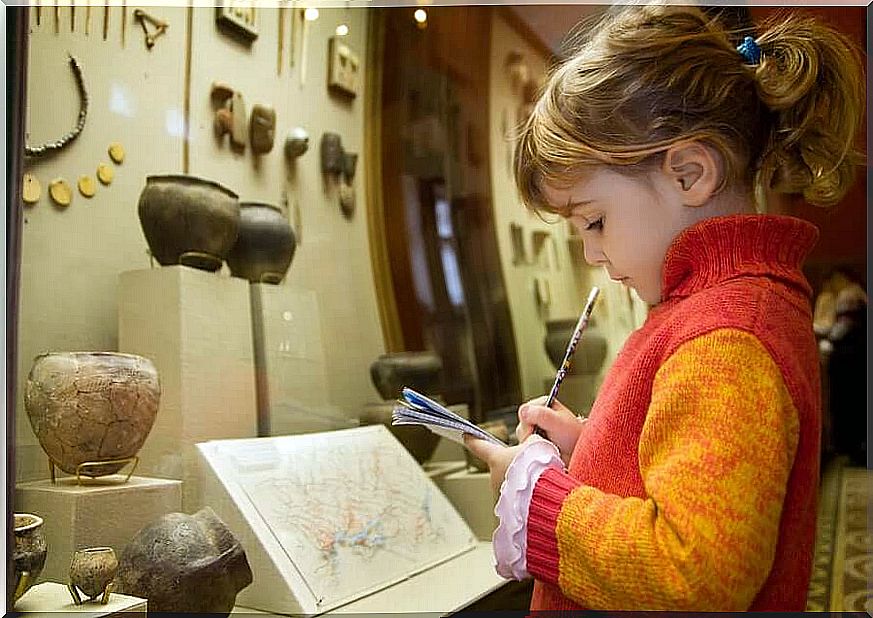How Can I Encourage Children’s Interest In Museums?
Going to a museum with children can be interesting and fun. Today we have some tips for you to help your children enjoy this educational activity.

Would you like to arouse your children’s interest in museums? Then read on, because we have some practical tips for you so that your little ones can enjoy this great learning activity with the whole family.
Museums teach us interesting things about science, art and other areas of knowledge. They arouse the interest of the little ones to learn more about our world. There are more and more museums that attract children with interactive and modern activities that make them fun and interesting. You should nurture your children’s interest by setting an example yourself.
Why visit museums with children?

Visiting a museum can be very exciting and educational, but some parents and educators fear the children’s reaction, as they often see these family activities or school trips as boring and uninteresting. “I will be bored”, “There is nothing interesting there” or “This is only for adults” are sentences that you get to hear from children over and over again when a museum visit is planned.
Despite these negative comments, parents shouldn’t let themselves be deterred from taking their children to museums. The smallest of the family (and also older children or young people) can experience an unforgettable experience there and have the chance to learn many new things.
You can immerse yourself in a themed world and discover interesting things. Of course, it is important to get children interested beforehand so that they can have fun while they learn new things.
Stimulate children’s interest in museums
Then we will present you with various useful recommendations to promote the curiosity of your children. You will love visiting museums with the family!
1. Choose the right museum
You have to choose a museum that your child is interested in. If your child is fascinated by dinosaurs, find a way to visit a museum dedicated to the subject. Maybe your offspring are interested in technology and there is a corresponding museum in your city with interactive machines that allow your child to experiment for themselves.
Think about what your child might be interested in and what opportunities there are in your environment. This is a better way of getting your offspring to visit museums. There are many great museums for children in which they can participate and not just passively view exhibits. Inform you!
2. Talk to your child

Children often express opinions without knowing what exactly they are about. You get infected by friends who may make a negative comment about museums. Does your child know what a museum is and what they will see there? If it has never been to the museum, it cannot have an opinion about it.
Explain to your child what they will see in the chosen museum, how they should behave there and what is going to be done in the museum. Talking to your child is very important so that they can understand the proposed activities.
3. Share your experiences with your child
Empathy is very important in all parts of our life, especially when it comes to our children. Tell your children a story you once experienced in a museum to pique their interest. If your child has already been bored in a museum, you can tell them about similar experiences and then tell them about a fun event that you yourself had a lot of fun in a museum.
Try to put yourself in your child’s shoes, because that way you can strengthen the relationship with them at the same time. Your child will feel understood in this way and you will achieve that they listen to you and respect your opinion.
4. Prepare for the visit
Interest in museums also depends very much on the preparation of this event. Give your child different choices and then prepare them for them. If you want to visit a railway museum, read stories on the topic with him beforehand or watch a suitable film together. In this way you can encourage the curiosity of your child who will ask themselves various questions about this topic.
You can also prepare activities before visiting the museum:
- Give your child coloring pages that go with the topic.
- Prepare questions about the topic, which will then be answered in the museum.
- Print out pictures of trains, dinosaurs, paintings, or anything else you’ll see in the museum. This is how your child can look for it when visiting the museum.
Check out the website of the museum you choose, as many have materials and activities for children to prepare for their visit.
5. Have an adventure together

You can include other entertaining activities as part of your visit to the museum. You can go out to eat together and then go to a playground afterwards. Your child can recover from the “pressure” in the museum at the same time.
6. Lower your expectations
You shouldn’t plan on spending all afternoon at the museum. Your child should feel comfortable doing this, and if they get bored, it’s best to do something else. Otherwise it won’t feel like it the next time.
7. Full stomach, empty bladder
This seems obvious, but remember: in order for your child to enjoy the visit, they shouldn’t be hungry and go to the bathroom first. Only when the basic needs are met can your child concentrate on the exhibits.
8. Be patient in museums
Visiting the museum should be a fun family outing. Remember, this is a new experience for your child. Therefore, you should be patient, answer all questions, and watch carefully when your child needs a break.
We hope that these tips will make your next visit to the museum unsuitable! Enjoy the time together with the whole family.









